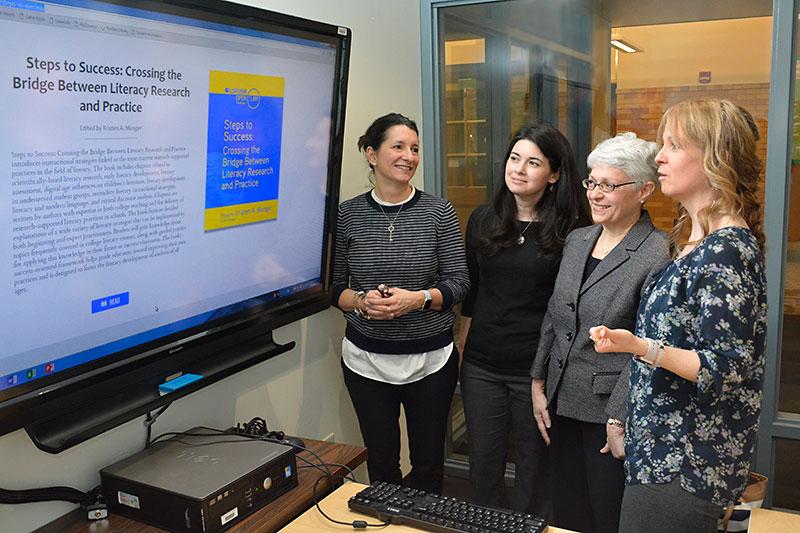Advancing literacy—SUNY Oswego School of Education Associate Dean Kristen Munger (right)—editor and co-author of an Open SUNY textbook geared toward improving research-based literacy teaching practices among those learning to be educators or growing in the profession—takes a large-screen look at the free, published result. Co-authors include curriculum and instruction faculty members Maria Murray (left) and Joanne O’Toole (second from right), as well as Michelle Duffy of Virginia Commonwealth University’s department of teaching and learning.
Kristen Munger, associate dean of the SUNY Oswego School of Education, has edited and co-authored a new Open SUNY textbook on research-driven literacy teaching practices.
“Steps for Success: Crossing the Bridge Between Literacy Research and Practice” recently became the college’s first contribution to the open-access library of State University-published textbooks.
“One of the biggest motivations for me was being able to publish this under a Creative Commons license and make it available for free,” Munger said. “I think we’re on the cutting edge of open educational resources with Open SUNY.”
Besides Munger herself, chapter contributors—all of whom are connected through graduate school at Syracuse University—include SUNY Oswego School of Education curriculum and instruction faculty members Maria Murray and Joanne O’Toole, as well as former member Elizabeth Stevens, now at Roberts Wesleyan College.
With the advent of the internet, social media, exploding availability of video and many other information and entertainment modes, the concept of “literacy” has moved with the times.
“Positively, things have changed,” Munger said. “The notion of what defines literacy is absolutely evolving. There are no longer constraints on how literacy should be thought of in terms of teaching and learning. In the book, we define literacy as involving reading, writing, listening, speaking, viewing and performing. All of these are different ways of taking in information and being able to express it. They all have legitimacy. We are helping people to utilize all expressive modes and to have flexibility on how they take in information.”
Another broad but intentional theme of the book is social justice. All children—and all teachers—need and deserve quality preparation, Munger said. She expressed delight that educators around the world can access and use the book.
“With an app for an e-reader, I can read the text online. I can hit a button and it speaks the text—it reads it aloud to me,” she said.
Applied learning
Specially targeting students learning how to practice literacy education and current educators seeking to stay up to date, Munger said, each chapter is written in accessible language and includes a summary, questions and activities designed to reinforce the material. The internal consistency notwithstanding, each chapter could stand alone, she said.
“As editor, I got to decide what the structure and what some of the emphases of the text would be,” said Munger, a former school psychologist whose doctorate is in reading education. “We wanted people who were trying to deepen their knowledge about literacy research practices to be able to apply the knowledge and to understand the conditions under which the research could be applied in their own classrooms.”
The 228-page book includes chapters by faculty working in literacy at Fairfield University in Connecticut, Towson University in Maryland, Dickinson College in Pennsylvania, Old Dominion University in Virginia and Virginia Commonwealth University, as well as Roberts Wesleyan in Rochester and Utica College.
Munger’s three chapters cover introductory material such as definitions of literacy, ideas for evaluating scientifically based approaches to literacy instruction, and literacy assessment. Murray contributed two chapters on word and language comprehension as essential components of reading comprehension, and O’Toole wrote about world language and literacy learning.
To access the Open SUNY library and view upcoming titles, visit www.opensuny.org. For more information on literacy and other opportunities in education at SUNY Oswego, visit www.oswego.edu/education.




